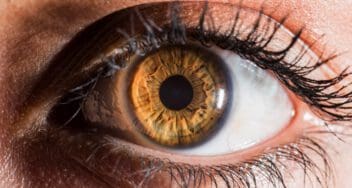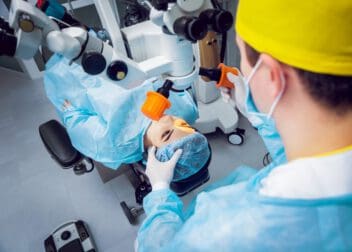Can Dilated Pupils Be Dangerous? (When to Worry)
Home / Vision Education Center /
Last Updated:
In many cases, pupil dilation is a natural response to poor lighting conditions, fear or shock, or interest (sexual or otherwise). It will likely pass when the external stimulus is no longer in the picture.
Table of Contents
When the dilation is caused by drugs, alcohol, an injury to the eye or head, or another condition that requires medical assistance, the pupils may not return to their undilated state. This can cause a number of undesirable effects, including pain in the eyes, vision problems, headaches, dizziness, confusion, and difficulty balancing and coordinating movement. If treatment is not received, these can become long-term problems.
People who have dilated pupils will be more sensitive to sunlight (or bright lights in general), since their pupils cannot constrict to protect the eyes from exposure to too much light. While there are medications and treatments to address this problem, these patients can also use eyeglasses with photochromic lenses, which automatically darken in bright light conditions to protect the eyes from too much light. Alternately, sunglasses with polarized lenses will reduce the glare from bright lights.
Custom prosthetic lenses can reduce the sensitivity to light caused by dilated pupils. They can also help to improve the appearance of the eyes (albeit only cosmetically) for people who have concerns about how their dilated pupils might appear to others. Prosthetic contact lenses create the appearance of having normal sized pupils, even if the pupils themselves are actually still dilated. They also offer some protection from harmful light levels.
Pupil dilation is the result of the two muscles in the iris working in tandem to enlarge the pupil. This usually occurs to see better in poor conditions, but it can also occur because of excitement, fear, or sexual arousal.
Pupils should return to their normal size when the stimulus passes, but some conditions can keep the pupil stuck in its dilated state, causing pain, dry eyes, and difficulty focusing. Most often, this is caused by concussion, PTSD, head or eye injuries, and substance abuse.
A combination of corrective surgery, protective lenses, and medication can restore the proper functioning of the pupil.
What Is Pupil Dilation?

When a pupil is dilated, it is larger than it normally should be.
Pupil size is controlled by two muscles in the iris (the iris sphincter and the iris dilator), as well as the amount of light that is directed at the eyes. In bright conditions, the pupils get smaller (constrict) to make sure that the eyes are not damaged by too much light. In darker conditions, the pupils get larger (or dilate) to let as much light as possible in.
You deserve clear vision. We can help.
With 135+ locations and over 2.5 million procedures performed, our board-certified eye surgeons deliver results you can trust. Your journey to better vision starts here.
That is how pupils should normally work, but there are other factors that can cause pupils to dilate. Under these conditions, abnormal pupil dilation is known as mydriasis. These factors can include certain types of drugs (recreational or medicinal), alcoholic beverages, and physiological reactions, such as fear or sexual arousal.
The Parasympathetic & Sympathetic Nervous Systems
As Scientific American writes, the body’s parasympathetic nervous system (which also controls the body’s autonomic processes when the body is at rest) is responsible for triggering the iris sphincter response. The sympathetic nervous system is what activates the iris dilator.
Stimulant drugs (such as Adderall, Ritalin, methamphetamine, and cocaine) target both the parasympathetic and sympathetic nervous systems (either individually or together), and forcefully trigger the respective systems into activating the muscles that dilate the pupils. This is due to the chemical compounds in the drugs that affect the neurotransmitters in the brain, manipulating the respective nervous systems to put the pupils into a state of dilation.
Many drugs can do this, not only stimulants. Selective serotonin reuptake inhibitors (antidepressants), hallucinogens like MDMA and LSD, and psychedelics like mescaline and psilocybin all trigger the receptors in the brain that induce the parasympathetic and sympathetic nervous systems. Other drugs (like marijuana) target adrenergic receptors, which the Progress in Retinal and Eye Research journal explains will also result in pupil dilation.
Drugs & Pupil Dilation
The pupils should return to their normal size after the body breaks down the drug and alcohol in the blood, but as Review of Optometry writes, repeated use of those substances can cause permanent damage to the respective nervous systems. The continuous dilation of the pupils can cause long-term vision problems.
For example, age-related macular degeneration normally occurs in people over the age of 50, but substance abuse will increase the likelihood of loss of vision due to degeneration, and it will exacerbate its effects.
Cocaine can inflame the corneas — a condition known as keratitis. Cocaine can also cause degeneration of the retina, or maculopathy. This is also an age-related condition that can be made worse by cocaine use, causing the central part of a patient’s field of view to become unfocused and blurry.
Chronic alcohol consumption can cause dry eye syndrome, where the eye cannot lubricate itself. Substance-induced glaucoma, affecting the fluid pressure in the eye, can also stem from alcohol abuse.
Using contaminated needles can cause endophthalmitis, which is inflammation of the intraocular fluids.
Drug or Alcohol Poisoning Signs in Patients with Dilated Pupils
Besides swollen pupils, substance intoxication may manifest in several other ways. In most cases, caffeine overdose may result in complications like abnormal heart rhythm/rate, seizure, and mental issues.
A stimulant like methamphetamine can cause irritability and increased alertness along with corneal complications. Alcohol intoxication can eventually cause premature farsightedness and other vision disorders.
You deserve clear vision. We can help.
With 135+ locations and over 2.5 million procedures performed, our board-certified eye surgeons deliver results you can trust. Your journey to better vision starts here.
Injuries & Attraction

There are many other factors that can cause a pupil to become dilated. According to BMJ, if the eyeball sustains a serious injury (where it is actually penetrated), the pupil’s shape can be changed so it is stuck in a dilated position (until it is surgically repaired). This kind of injury is also a risk during eye surgery itself, such as during a corneal transplant or cataract surgery.
Similarly, the Surgical Neurology Journal writes that an injury to the head (which impacts the brain) can also change how the pupils react to light, causing dilation. This is why, when a person suffers a head injury, doctors or emergency responders will immediately check the person’s eyes with a penlight.
And according to the Journal of Neurology, Neurosurgery and Psychiatry, strokes and brain tumors can have similar effects.
Sexual attraction is a very common phenomenon that corresponds with pupil dilation. It is a form of the parasympathetic nervous system and the sympathetic nervous system trying to get as much “information” about the object of sexual interest as possible, by causing the pupils to become larger (to try and “see” better).
Effects & Treatments
In many cases, pupil dilation is a natural response to poor lighting conditions, fear or shock, or interest (sexual or otherwise). It will likely pass when the external stimulus is no longer in the picture.
When the dilation is caused by drugs, alcohol, an injury to the eye or head, or another condition that requires medical assistance, the pupils may not return to their undilated state. This can cause a number of undesirable effects, including pain in the eyes, vision problems, headaches, dizziness, confusion, and difficulty balancing and coordinating movement. If treatment is not received, these can become long-term problems.
People who have dilated pupils will be more sensitive to sunlight (or bright lights in general), since their pupils cannot constrict to protect the eyes from exposure to too much light. While there are medications and treatments to address this problem, these patients can also use eyeglasses with photochromic lenses, which automatically darken in bright light conditions to protect the eyes from too much light. Alternately, sunglasses with polarized lenses will reduce the glare from bright lights.
What to do if Your Pupils are Not the Same Size
If your pupils get and remain bigger for no apparent reason, you should see your primary physician or ophthalmologist right away. Getting quick medical help can prevent vision loss or even a death-threatening medical condition in scenarios such as:
- Pupils swell after head injury (emergency care is necessary)
- Pupils get bigger along with symptoms like headache and lightheadedness
Surgery & Medication

For the most part, treating dilated pupils involves understanding what first caused the dilation and addressing that. Whatever treatment is attempted should aim to protect the functioning of the eyes and restore the pupils to their normal state.
For example, if the mydriasis is caused by an adverse reaction to prescription medication, a doctor will recommend waiting for the effects of the medication to wear off and not taking that drug again. It will be up to the doctor to find an alternative drug that does not cause pupil dilation.
Pupil dilation caused by injury to the head, brain, or eyes will require more hands-on treatment. In cases like these, patients often undergo surgery to repair the damage to their nerves and/or their eye structures. When discharged, patients are usually given eye patches or specialized corrective lenses, to protect their pupils until they are ready to gradually be exposed to increasing levels of light.
Additionally, they may be given pilocarpine, a medication that is normally used in the treatment of glaucoma. Low doses can be prescribed to help the pupils constrict and regain their flexibility. When the pupils are able to dilate and constrict on their own (with continued assistance from corrective lenses and lifestyle changes, as necessary), pilocarpine can be discontinued.
You deserve clear vision. We can help.
With 135+ locations and over 2.5 million procedures performed, our board-certified eye surgeons deliver results you can trust. Your journey to better vision starts here.
References
- Is There a Cure for Mydriasis (Dilated Pupils)? (December 13, 2016). American Academy of Ophthalmology.
- Eye-Opener: Why Do Pupils Dilate in Response to Emotional States? (December 7, 2012). Scientific American.
- Psychostimulant. Science Direct.
- Endocannabinoids in the Retina: From Marijuana to Neuroprotection. (September 2008). Progress in Retinal and Eye Research.
- How Drug Abuse Affects the Eye. (September 15, 2018). Review of Optometry.
- Injury to the Eye. (January 2004). BMJ.
- Lasting Bilateral Mydriasis After Traumatic Brain Injury May Not Always Be A Lost Case. (2017). Surgical Neurology International.
- Fixed And Dilated Pupils After Trauma, Stroke, And Previous Intracranial Surgery: Management And Outcome. (2001). Journal of Neurology, Neurosurgery & Psychiatry.
- 5 Things That Happen To Your Body As Soon As You are Sexually Attracted To Somebody. (November 2015). Bustle.
- The Pros and Cons of Transition Sunglass Lenses. (June 30, 2017). American Academy of Ophthalmology.
- Prosthetic Contact Lenses in Post-Concussion Photophobia. (June 2015). Investigative Ophthalmology and Visual Science.
- Photophobia and Light-Induced Headache: Novel Long-Term Effects of Pilocarpine. (June 2013). Investigative Ophthalmology and Visual Science.
- Concerned About Dilated Pupils? Causes and Treatment. (July 1, 2021). American Academy of Ophthalmology.
- Caffeine Toxicity. (June 29, 2021) StatPearls.
This content is for informational purposes only. It may have been reviewed by a licensed physician, but is not intended to serve as a substitute for professional medical advice. Always consult your healthcare provider with any health concerns. For more, read our Privacy Policy and Editorial Policy.